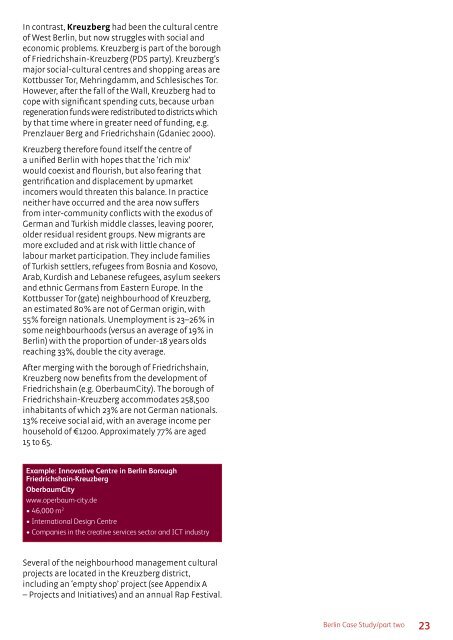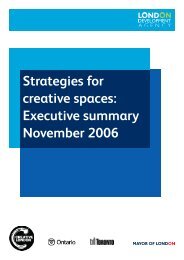Berlin Case Study - Cities Institute
Berlin Case Study - Cities Institute
Berlin Case Study - Cities Institute
You also want an ePaper? Increase the reach of your titles
YUMPU automatically turns print PDFs into web optimized ePapers that Google loves.
In contrast, Kreuzberg had been the cultural centre<br />
of West <strong>Berlin</strong>, but now struggles with social and<br />
economic problems. Kreuzberg is part of the borough<br />
of Friedrichshain-Kreuzberg (PDS party). Kreuzberg’s<br />
major social-cultural centres and shopping areas are<br />
Kottbusser Tor, Mehringdamm, and Schlesisches Tor.<br />
However, after the fall of the Wall, Kreuzberg had to<br />
cope with significant spending cuts, because urban<br />
regeneration funds were redistributed to districts which<br />
by that time where in greater need of funding, e.g.<br />
Prenzlauer Berg and Friedrichshain (Gdaniec 2000).<br />
Kreuzberg therefore found itself the centre of<br />
a unified <strong>Berlin</strong> with hopes that the ‘rich mix’<br />
would coexist and flourish, but also fearing that<br />
gentrification and displacement by upmarket<br />
incomers would threaten this balance. In practice<br />
neither have occurred and the area now suffers<br />
from inter-community conflicts with the exodus of<br />
German and Turkish middle classes, leaving poorer,<br />
older residual resident groups. New migrants are<br />
more excluded and at risk with little chance of<br />
labour market participation. They include families<br />
of Turkish settlers, refugees from Bosnia and Kosovo,<br />
Arab, Kurdish and Lebanese refugees, asylum seekers<br />
and ethnic Germans from Eastern Europe. In the<br />
Kottbusser Tor (gate) neighbourhood of Kreuzberg,<br />
an estimated 80% are not of German origin, with<br />
55% foreign nationals. Unemployment is 23–26% in<br />
some neighbourhoods (versus an average of 19% in<br />
<strong>Berlin</strong>) with the proportion of under-18 years olds<br />
reaching 33%, double the city average.<br />
After merging with the borough of Friedrichshain,<br />
Kreuzberg now benefits from the development of<br />
Friedrichshain (e.g. OberbaumCity). The borough of<br />
Friedrichshain-Kreuzberg accommodates 258,500<br />
inhabitants of which 23% are not German nationals.<br />
13% receive social aid, with an average income per<br />
household of €1200. Approximately 77% are aged<br />
15 to 65.<br />
Example: Innovative Centre in <strong>Berlin</strong> Borough<br />
Friedrichshain-Kreuzberg<br />
OberbaumCity<br />
www.operbaum-city.de<br />
• 46,000 m 2<br />
• International Design Centre<br />
• Companies in the creative services sector and ICT industry<br />
Several of the neighbourhood management cultural<br />
projects are located in the Kreuzberg district,<br />
including an ‘empty shop’ project (see Appendix A<br />
– Projects and Initiatives) and an annual Rap Festival.<br />
<strong>Berlin</strong> <strong>Case</strong> <strong>Study</strong>/part two<br />
23




